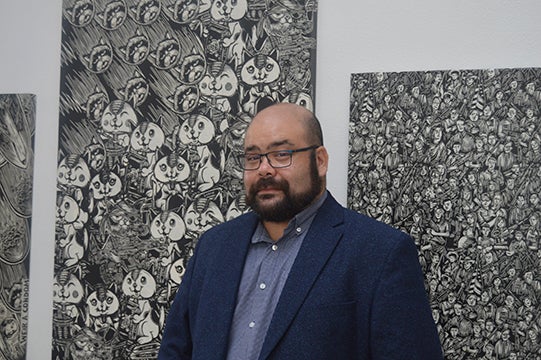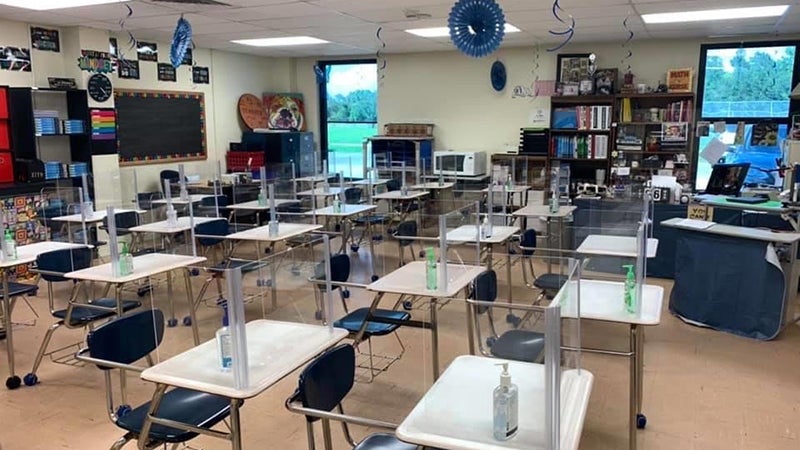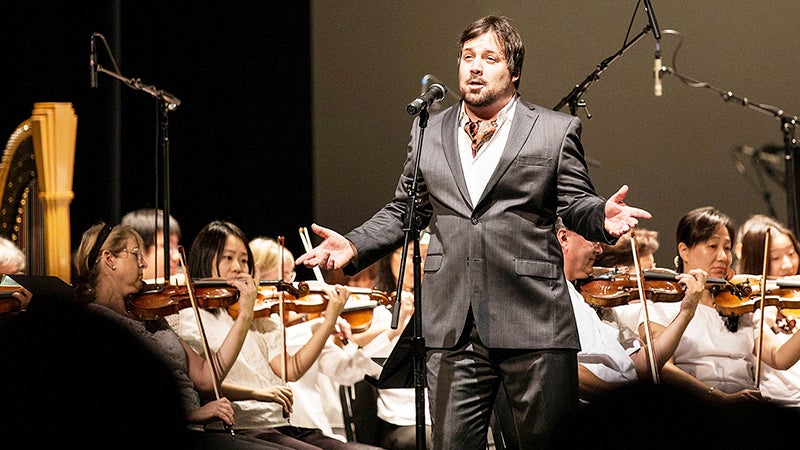Promoting creativity: Local artist to teach graphic design at LSCPA
Published 9:53 pm Wednesday, August 15, 2018

- Local artist Maurice Abelman will be the new graphic design program instructor for Lamar State College Port Arthur. Here Abelman stands in the art studio he shares with a fellow artist in Beaumont. (Lorenzo Salinas/The News)
Lamar State College Port Arthur has hired a new instructor for its graphic design program: Maurice Abelman.
Abelman is a local artist and graphic designer who has been in the industry since 2000 — although, he has been an artist arguably his entire life.
“I have a mixed background when it comes to creativity — in the commercial field dealing with graphic design and my fine art background that normal graphic designers might not have pushed toward,” Abelman said.
“Maybe I can inspire students to do that as well — to be creative and at the same time to have that creativity have a function as well.”
Getting the job
A couple of colleagues from the college had recommended Abelman for the position.
“I thought it was a good opportunity and I wanted to see what I could do with teaching,” Abelman said. “I wanted to see if the knowledge I’ve gained so far would be interesting for students.”
Abelman earned both a Bachelor and a Master of Fine Arts from Lamar University. He credits several of its teachers for inspiring him to take his art to the next level.
“Graphic design for me takes an abstract idea and creates a visual representation of that idea. It represents some concept or form and expresses it,” he said.
Abelman likened the graphic design field to a form of visual persuasion, where one is not persuading with words but rather with a visual image.
“You’re persuading people with visual elements to engage with the product,” he said.
His resume consists of a wide variety of media, including drawing, painting, sculpture, woodwork and an interactive exhibit known as installation.
What it takes
According to Abelman, aspiring graphic designers have to be a super collection of different talents and skills that utilize both cutting-edge tech and traditional art techniques.
“Graphic designers need to advance with the times,” he said. “Everything is leaning more toward the Internet — there’s a certain amount of traditional print that will never die — but technology is surpassing it in graphic design.
“I’ll be trying to communicate that to my students, along with a greater emphasis on creativity.”
Abelman argued that creativity is one of the things advertising agencies should look for because that’s what their client base would look for as well.
“Coming from a graphic design and marketing industry background, I feel I have some experience to help them develop their portfolios and to get them started in the job market — and to still love what they do and be super creative,” he said.
In detailing how a typical designer applies his art for a client, Abelman highlighted an important question.
“When you’re creating work for a client, you have to ask yourself ‘How can I help that person’s business?’ It’s more about putting your own ego to the side and about using your own skills to be creative for them,” he said.
Teaching his passion
While the teaching field would be new to him, his passion for instilling the joy of art in others is not.
“I’m super excited about it, about being able to work with students on cool projects,” Abelman said. “I’m super stoked about it; we’re all going to learn so much from it. I’m still new to teaching, but I’m passionate about what I do.”
Abelman starts teaching at the beginning of the semester in August. He has already taken into consideration how to apply a grading rubric to a subjective field like art.
“From a design point of view, I try to break it down into three categories.
“One, with every project, you have to be able to understand the project. There are elements of research that will be graded upon. For each project we do, there will be a degree of research to it.
“Then there’s the technical skill — how well they can render imagery and dealing with certain programs on the computer, in addition how to illustrate them.
“Finally there’s creativity, which is very subjective and very inspired by the research they do and the technicality they do it with.”
Art as language
Abelman is a firm believer in the universality of art.
“I believe there is a core similarity that everyone shares as a species. Yeah, we grew up in different parts of the world at different times, but we share something between us that art can transcend. I want to see if we can use art to transcend those barriers,” Abelman said.
“I think one of the strengths of visual design is something I want to infuse with my students. Visual design, whether it’s graphic design or digital art, you can use anything beyond the language you’re using and focus more on the visual elements.”
Abelman said one could use the visual arts to communicate to a wide audience because it’s not relegated to any one written language; it’s conveyed through the universal language of art.
“The days of going through the gallery and museum to get in touch with your audience base still exists, but they’re fading away. There’s a new avenue to communicate with your audience.”
Abelman mentioned online platforms like DeviantArt and Patreon as digital venues for new and veteran artists alike to showcase their works and make money from them.
He said the Internet and technology have changed the way people can access the universal language of art.





